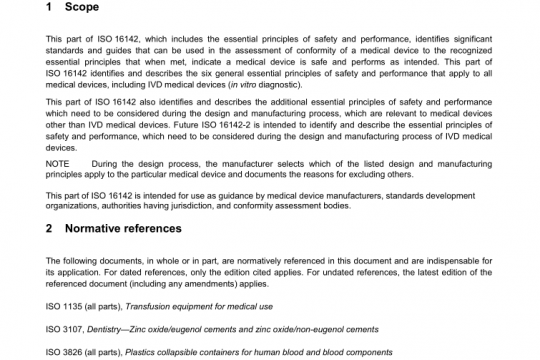ANSI AAMI RD52 pdf free download
ANSI AAMI RD52 pdf free download.Dialysate for hemodialysis.
3 Definitions
For the purposes of this recommended practice, the following terms and definitions apply.
3.1 acetate concentrate: Concentrated solution of salts that may contain dextrose (sometimes referred to as “glucose”), which, when diluted with water, yields dialysate for use in dialysis. Sodium acetate is normally used as the buffer. This concentrate is used as a single concentrate.
3.2 acetate dialysate: Dialysate without bicarbonate, using acetate as a substitute for the bicarbonate buffer. NOTE—Acetate dialyzing fluid is generally produced from a single concentrate. Acetate is metabolized by the patient to produce bicarbonate.
3.3 acid concentrate: Acidified concentrated solution of salts that may contain dextrose (sometimes referred to as “glucose”), which, when diluted with water and bicarbonate concentrate, yields dialysate for use in dialysis. The term “acid” refers to the small amount of acid (usually acetic acid) that is included in the concentrate to establish the buffer system in the final dialysate by reaction with a small amount of bicarbonate from the bicarbonate concentrate.
3.4 action level: Concentration of a contaminant at which steps should be taken to interrupt the trend toward higher, unacceptable levels.
3.5 anions: Ions carrying a negative charge.
3.6 bacteriology: Area of study within the field of microbiology that deals with the study of bacteria.
3.7 batch system: Apparatus in which the dialysate is prepared in bulk before each dialysis session.
3.8 bicarbonate concentrate: Concentrated solution of sodium bicarbonate that, when diluted with water and acid concentrate, makes dialysate used for dialysis. Some bicarbonate concentrates also contain sodium chloride.
3.9 bicarbonate dialysate: Dialysate containing physiological or higher concentrations of bicarbonate. NOTE—Bicarbonate dialysate is generally produced from two concentrates: one containing bicarbonate and the other containing acid and other electrolytes (see acid concentrate and bicarbonate concentrate).
3.10 biofilm: Coating on surfaces that consists of microcolonies of bacteria embedded in a protective extracellular matrix. The matrix, a slimy material secreted by the cells, protects the bacteria from antibiotics and chemical disinfectants.
3.11 bulk delivery: Delivery of large volumes of concentrate in which the product is transferred (pumped) from the delivery container to a user’s storage tank. Bulk delivery may include containers such as 55 gallon drums, which are pumped into a storage tank maintained at the user’s facility.
3.12 cations: Ions carrying a positive charge.
3.13 chlorine, combined: Chlorine that is chemically combined, such as in chloramine compounds.
NOTE—There is no direct test for measuring combined chlorine, but it can be measured indirectly by measuring both total and free chlorine and calculating the difference.
3.14 chlorine, free: Dissolved molecular chlorine.
3.15 colony-forming unit (CFU): Organism capable of replicating to form a distinct, visible colony on a culture
plate. In practice, a colony may be formed by a group of organisms.
3.16 concentrate generators: System in which the concentrate is delivered to the consumer as a powder in a
container and then converted on-line into a saturated solution by a dialysis delivery machine. This solution is used by
an individual proportioning system to make the final dialysate delivered to the dialyzer.
3.17 dialysate: Aqueous fluid containing electrolytes and, usually, dextrose, which is intended to exchange solutes with blood during hemodialysis. The word “dialysate” is used throughout this document to mean the fluid made from water and concentrates that is delivered to the dialyzer by the dialysate supply system. Such phrases as “dialyzing fluid” or “dialysis solution” may be used in place of dialysate.ANSI AAMI RD52 pdf download.
Other IEC Standards
-

ANSI AAMI ISO 16142-1 pdf free download – non-IVD medical devices and guidance on the selection of standards
AAMI standards list DOWNLOAD -

ANSI AAMI ISO 16142-2 pdf free download – General essential principles and additional specifc essential principles
AAMI standards list DOWNLOAD


